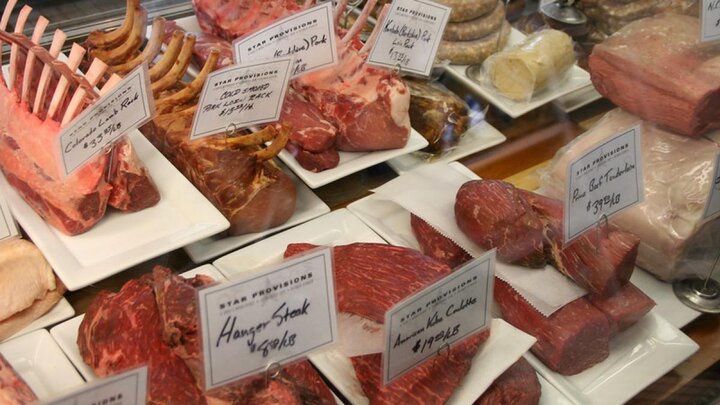The following is a summary of the webinar “The Growing Role of Exports” given on June 3, 2021, as part of the Department of Agricultural Economics at the University of Nebraska-Lincoln Extension Farm and Ranch Management team’s weekly webinar series. The webinar can be accessed here and an accompanying podcast can be accessed above. Both are provided free to the public.
USMEF Overview
USMEF is a non-profit trade association that represents the export interests of the U.S. beef, pork, and lamb industries through its network of offices and representatives in foreign markets. Headquartered in Denver, Colorado, USMEF has developed an extensive network of international offices and representatives to develop opportunities for the U.S. industry. These offices conduct activities in 95 different countries. USMEF shares its local intelligence and more than four decades of experience with U.S. exporters, traders and buyers in addition to end users and processors in each market. USMEF receives funding and support from USDA and the beef, pork, lamb, corn, and soybean checkoff programs, as well as its membership which includes a broad cross-section of American agriculture: farmers; meat packers, processors, purveyors and traders; agribusinesses with an interest in U.S. meat exports; and other agricultural organizations (https://www.usmef.org/).
Global Demand for Red Meat
We are seeing strong global demand for red meat, even as the covid-comeback remains mixed, with the worst of the pandemic hitting in Taiwan, for example, and with continued restrictions in Japan, Korea, and across southeast Asia. Despite these varying restrictions particularly on foodservice, gatherings, travel, and tourism, demand for U.S. red meat has been strong. Some of the key trends we have seen this year, in Korea for example, but many with relevance across markets include high quality, fresh food, food delivery, convenience, eco friendly and sustainability, atrium-style shopping, and outdoor dining, home party, and camping craze, and strong demand for bone-in cuts. There is heightened awareness of health and nutrition, and USMEF has been communicating, including through the various digital platforms, the positive health, convenience, and sustainability messages to encourage consumption of U.S. red meat around the world.
In the current tight global supply situation, we maintain advantages. Our biggest competitor on the beef side, Australia, is in strong herd-rebuilding mode and this is limiting both production and exports, which were down 24% through May and are expected to end this year down at least 12%. On the pork side, Germany lost access to the big markets when ASF was found in wild boar last September and this continues to impact trade within and out of the EU. EU producers also face uncertainty from the Green Deal and the European Commission’s Farm to Fork Strategy. Additional animal welfare and environmental requirements are further pressuring production in Germany.
Beef Exports Now and Moving Forward
The U.S. is the largest beef exporter on a value basis, and trailing only Brazil on volume; and the largest pork exporter. Exports have been the driver of growth in the U.S. industry, with the production of both beef and pork increasing by about 15% when comparing 2020 to 2015 volume. Over the same time, exports of pork increased by 39% and beef increased by 18%. Per capita consumption (or disappearance) within the U.S. remained quite steady to slightly higher over that period, as the U.S. industry was able to meet both domestic and export demand.
The big game-changer for U.S. beef exports this year is China. U.S. beef exports to China soared to more than 40,000 mt in the first four months of this year, compared to less than 3,000 mt in the same period last year. The U.S. is now the biggest grain-fed supplier of beef to China, even as U.S. beef accounts for just 3% of China’s total beef imports. China has now climbed to the #3 position as a top customer for U.S. beef, following only Korea and Japan.
The strong growth in exports to China, and Korea at another record pace, have helped to underpin higher prices for U.S. beef cuts. Since we already export a significant share of products like short plate, rib short ribs, chuck short ribs, and other chuck items, the increased competition from Chinese buyers drives higher prices. And USMEF is working hard to encourage international customers to buy a wider range of cuts, including those from the round. USMEF expects U.S. beef and beef variety meat exports to set a new record, up at least 9% from last year and reaching 1.37 million mt, valued at about $8.7 billion, up 14%.
Pork Exports Now and Moving Forward
U.S. pork exports to China slowed from the torrid pace of last year, but remain historically large and growth elsewhere is expected to offset the pullback from China. China’s hog prices have plummeted and U.S. pork still faces a 25% retaliatory duty, related to the Section 232 metal tariffs; thus the current and expected slowdown in U.S. pork exports to China. But USMEF forecasts total U.S. pork and pork variety meat exports up 1-2% to just over 3 million mt, with value at about $8 billion. The growth will continue to be to Mexico, the Philippines, the Dominican Republic, and Central America, just as we have seen thus far this year. Shipping delays and logistical challenges, along with labor shortages across the entire chain, have taken the edge off export growth potential this year, but records are expected despite the constraints.
Exports account for a significant share of U.S. pork and beef production, especially for certain cuts, adding value to every animal we produce, and helping us capitalize on our natural resources and other advantages. In the first quarter of 2021, exports equated to $335.45 for each fed steer and heifer harvested in the same period. For pork exports averaged $61.86 for each head harvested in the first quarter. Exports enable us to sell each cut and variety of meat or offal product to the highest bidder around the world, taking into account different tastes and preferences, seasonal variations, importing country supply constraints, exchange rates, economic growth, and a whole host of variables. Exports underpin the profitability of the U.S. red meat industry and bring added growth opportunities.
Frequently Asked Questions
Q: Why and how are international consumers developing a taste preference for grain-finished beef and pork?
A: This is a trend that has been underway for the last several years. Most of these are the effects of long-term marketing and education programs in specific countries. These efforts have focused on teaching consumers how to prepare and cook different cuts of meat, the health and nutritional make-up of red meat products, and the sustainability aspect of producers and the industry at large. Combined, these long-term and sustained efforts have culminated in increased demand for both beef and pork products abroad.
Q: How do alternative protein products marketed internationally impact the growth of U.S. red meat exports?
A: Alternative proteins have historically not received a lot of media coverage in U.S. primary exporting countries except for Europe. Since COVID-19, there has been noticeably more media coverage on these types of products. We are still uncertain about how this added coverage will impact export demand. However, most consumers in exporting countries are already coming from a heavy plant-based food diet such as tofu or bean curd. Generally, consumers increase the quantity and quality of meat consumption as income rises. There is uncertainty if consumers will trade down to other alternative protein products once they have income sufficient to purchase red meat products.
Q: What does the current demand for red meat in Africa look like given declining populations in South East Asia?
A: Population is important for red meat demand but mostly for variety meat products. Pork and Beef cuts are priced relatively higher than other protein products so the number of households with larger incomes is of greater market signal to observe over time. While incomes in Africa are continuing to improve, there are many more high-income households in South East Asia and the rate of growth in the number of households is also improving more rapidly. That said, Africa, as well as places such as Central America, will be a place for red meat demand over the next 30 years. Currently, there are educational and marketing activities occurring in Africa to educate consumers and match local buyers with U.S. exporters.




